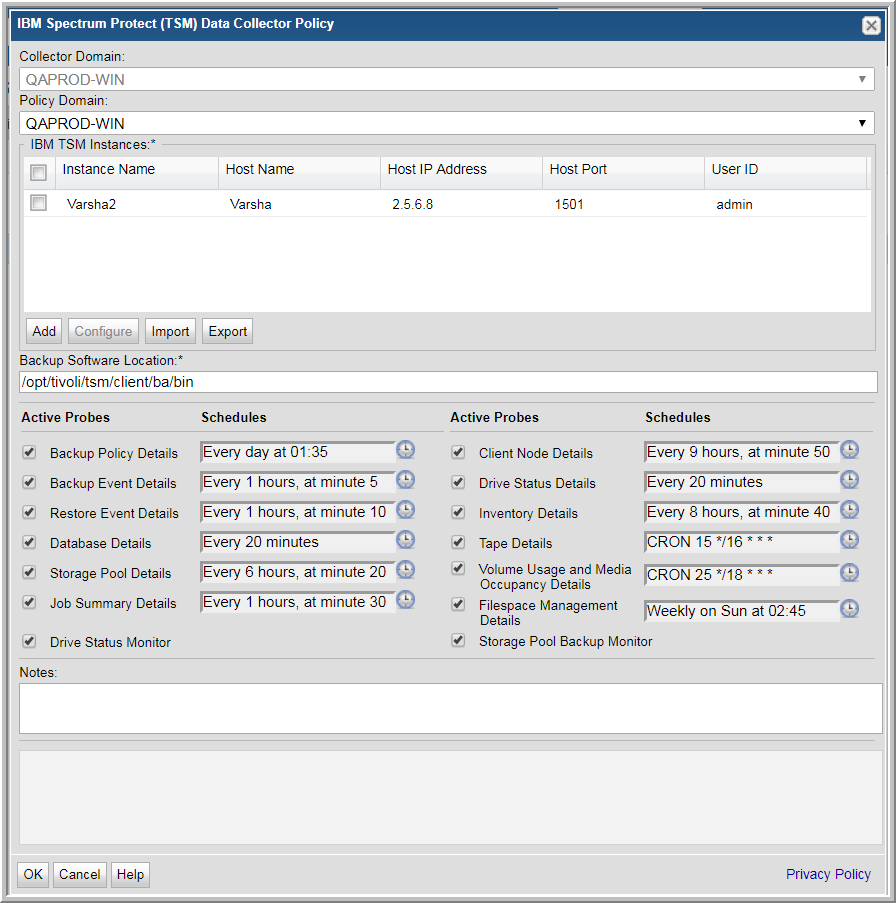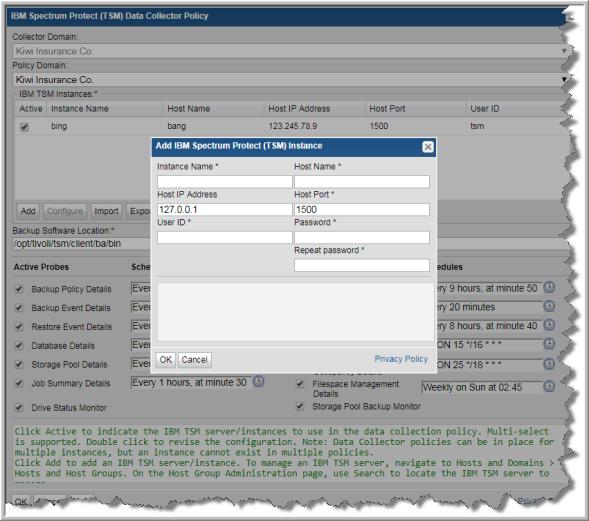

Field | Description |
Collector Domain | The domain of the collector to which the collector backup policy is being added. This is a read-only field. By default, the domain for a new policy will be the same as the domain for the collector. This field is set when you add a collector. |
Policy Domain | The Policy Domain is the domain of the policy that is being configured for the Data Collector. The Policy Domain must be set to the same value as the Collector Domain. (The Collector Domain is the domain that was supplied during the Data Collector installation process.) The domain identifies the top level of your host group hierarchy. All newly discovered hosts are added to the root host group associated with the Policy Domain. Typically, only one Policy Domain will be available in the drop-down list. If you are a Managed Services Provider, each of your customers will have a unique domain with its own host group hierarchy. To find your Domain name, click your login name and select My Profile from the menu. Your Domain name is displayed in your profile settings. |
IBM Spectrum Protect (TSM) Instances | |
Active | Click Active to indicate the IBM Spectrum Protect (TSM) server/instances to use in the data collection policy. Multi-select is supported. If additional fields must be configured, the Configure Server dialog is automatically displayed when you make your selection. |
Add | Click Add to add an IBM Spectrum Protect (TSM) server/instance. The IBM Spectrum Protect (TSM) servers added to this table using IBM Spectrum Protect (TSM) Data Collector Policy screen are also displayed in the Inventory Note: Data Collector policies can be in place for multiple instances, but an instance cannot exist in multiple policies. |
Configure | Select a row in the IBM Spectrum Protect (TSM) Instances table. Double-click or click Configure to revise or add information to the TSM server/instance you selected. See also
Adding/Configuring an IBM Spectrum Protect (TSM) Server within the Data Collector Policy. |
Import | Click Import to browse for the CSV file in which you entered the IBM Spectrum Protect (TSM) server/instance configuration details. This enables you quickly add a list of IBM Spectrum Protect (TSM) instances or servers. See also
Importing IBM Spectrum Protect (TSM) Information. |
Export | Click Export to create and download a comma-separated values (CSV) file containing all the host/instance information listed in the IBM Spectrum Protect (TSM) Instances table. This enables you to extract your IBM Spectrum Protect (TSM) server information and transfer it easily into a spreadsheet or some other media. See also
Exporting IBM Spectrum Protect (TSM) Server Information. |
Backup Software Location* | The home directory of the TSM Admin Client software—that is, the dsmadmc command on the Data Collector server. Typically C:\Program Files\Tivoli\TSM\baclient for Windows, or /opt/tivoli/tsm/client/ba/bin for Linux |
Active Probes and Schedules | |
Schedule | Click the clock icon to create a schedule. Every Minute, Hourly, Daily, Weekly, and Monthly schedules may be created. Advanced use of native CRON strings is also available. Note: Explicit schedules set for a Collector policy are relative to the time on the Collector server. Schedules with frequencies are relative to the time that the Data Collector was restarted. |
Backup Policy Details | Collects backup policy details including policy name, policy identifier, date and time as it relates to the specified IBM Spectrum Protect (TSM) instances/servers. |
Backup Event Details | Collects backup event details including backup type, client names, duration, dates, size, files, directories and so on. |
Restore Event Details | Collects restore event details such as job duration, number of files backed up and also skipped, amount of data restored, and restore job status. |
Database Details | Collects IBM Spectrum Protect (TSM) backup database details, such as total capacity, available space, cache hit percentages, and buffer requests. |
Storage Pool Details | Collects IBM Spectrum Protect (TSM) storage pool information, such as migration and reclamation details. |
Job Summary Details | Collects IBM Spectrum Protect (TSM) job summary details including client name, node name, backup type, dates, duration and so on, as it relates to the specified IBM Spectrum Protect (TSM) instances/servers. |
Client Node Details | Collects client node details covered by the selected policy domain as they relate to the specified IBM Spectrum Protect (TSM) instances/servers. |
Drive Status Monitor | Continuously monitors the IBM Spectrum Protect (TSM) console for drive status messages, there is no schedule. |
Drive Status Details | Collects drive status details including, drive name, library name, status, start and end times as it relates to the specified IBM Spectrum Protect (TSM) instances/servers. |
Inventory Details | Collects IBM Spectrum Protect (TSM) host details including host name, IP Address, Host ID, and port number. Also collects from drives and paths such as device type, device name, library name, and ACS drive ID. |
Tape Details | Collects the tape details including media type name, media status, storage pool name, and estimated capacity. |
Volume Usage and Media Occupancy Details | Collects client and node information, and then for each node it retrieves the volume usage details from the IBM Spectrum Protect (TSM) instance or server. For each volume, collects details of media occupying the storage pool. Details include the type and size of the media. |
Filespace Management Details | Collects filespace details such as capacity, backup start/finish dates, and the percentage of the filespace that is occupied. |
Storage Pool Backup Monitor | Continuously monitors the IBM Spectrum Protect (TSM) console for storage pool migration messages, there is no schedule. |
Notes | Enter or edit notes for your data collector policy. The maximum number of characters is 1024. Policy notes are retained along with the policy information for the specific vendor and displayed on the Collector Administration page as a column making them searchable as well. |

Field | Description |
Instance Name | The name assigned to the IBM Spectrum Protect (TSM) instance. This is a separate instance of the server software running on a IBM Spectrum Protect (TSM) server. A single server can run multiple instances. An instance is defined by instance name, host name, and port number. |
Host Name | The name of the IBM Spectrum Protect (TSM) server. This is the host running the IBM Spectrum Protect (TSM) server software. This system will be known by its host name. If you do not know the Host Name, you can enter the IP Address in this field. |
Host IP Address | The IP address of the host running the IBM Spectrum Protect (TSM) server software. By default it is set to 127.0.0.1. You can revise it as required and this field is not mandatory. |
Host Port | Port number used by dsmadmc to communicate with the IBM Spectrum Protect (TSM) Instance. Each instance will have its own specific port. By default it is set to 1500. You can revise it, but the field is required. |
User ID | IBM Spectrum Protect (TSM) user ID with query and select privileges. |
Password | Password associated with the IBM Spectrum Protect (TSM) administrator account credentials. |